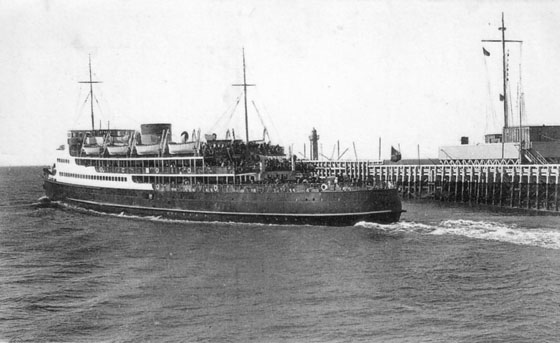
The main engines were Sulzer single-acting, two-stroke cycle crosshead type, each engine having 12 cylinders 580 mm.(22.8in) bore and 840 mm. (33.1in) stroke. The engines were arranged for airless injection of the fuel. The overall dimensions of each engine were :-Length, 45ft.9in (13.95m) ; height, 15ft11.5in (4.87m); and width, 7ft.2.5in (2.2m).
The 'Motor Ship' article wrote: ...the choice between double-acting and single-acting machinery was the subject of prolonged investigation and it was laid down originally that the propelling engines should not weigh more than 30kg per horsepower. Ultimately it was decided to order Sulzer type single-acting two-stroke machinery...under licence from Sulzer. From what has been described, it is evident that the 'Prince Baudouin' will be one of the most interesting vessels constructed for regular service, and she may have a very strong influence on the future trend of development of cross-Channel passenger ships.
When new this ship was the fastest motor vessel afloat, and most certainly the fastest ship to work the Ostend - Dover service. A speed of 25.25 knots was recorded shortly after completion. The title was previously held by the slightly larger 'Venus', which was also in service in the North Sea area, regularly sailing between Newcastle and Bergen. The 'Venus' was powered by two Burmeister & Wain four-stroke single-acting ten cylinder engines, each developing 5,000bhp at 155rpm.
After six years of service on the Ostend - Dover route the dark clouds of war saw a set of brand new horizons unfold for the Prince Baudouin after Belgium was overrun by the advancing German armies.

On May 18/19th 1940 the ship sailed from Ostend to Le Havre & Southampton with many refugees on board. During the voyage the ship came under attack from German aircraft. With the Prince Baudouin now in Allied hands it was transferred to the Ministry of War at the end of May 1940.
The ship was part of the force involved in the evacuation of Brest, Cherbourg & St Malo on June 17th 1940.
A month later the ship was transferred to the Royal Navy and became the HMS Prince Baudouin, pennant number LSI(S)-488. Now working for the Royal Navy the ship would see parts of the world that could never have been imagined as a lowly cross-Channel ferry.
During August 1941 the Prince Baudouin was involved with troop movements through the Mediterranean Sea to North Africa.
On the evening of September 30th 1941 the HMS Prince Baudouin sailed as part of Troop Convoy WS 12, departing from Gourock bound for Suez / Bombay. The convoy comprised twenty four ships on leaving Gourock with an average speed of just under twelve knots and rendezvous'd with the Liverpool section the next morning. En route the ship called in at Ponta Delgada, Azores from October 5th - 10th to refuel. Further south the convoy sailed from Freetown in the early afternoon of October 19th 1941. The Prince Baudouin departed the convoy during the evening of October 21st bound for St. Helena, arriving on 24th, refuelling and then sailing to rejoin the convoy on October 30th. On reaching the Cape Town area the convoy divided with the Prince Baudouin and ten other vessels entering Cape Town on October 29th. From December 1st 1941 to December 6th 1941 the ship was sailing between Durban & Mombasa. During January 1942 the ship was noted at Cape Town, South Africa.
Between November 16th & 26th 1942 the Prince Baudouin sailed from Bathurst to Londonderry.
In January 1943 the ship was converted to a landing vessel at Green & Silley Weir Ltd, Tilbury. Later, on the approach to D-Day the ship featured in publicity photographs showing troops using the ship for amphibious exercises at an English port. On D-Day itself HMS Prince Baudouin was active in the channel crossings as part of Assault Group O-4 led by Commander Dennis, RN. Alongside the Prince Baudouin were LSI's Prince Charles & Prince Leopold involved in landing the U.S. 5th Ranger Battalion at Omaha Beach on June 6th 1944. During July 1944 the ship assisted with troop landings in the south of France.
Following the end of World War II the ship was returned on October 13th 1945 to Ostend and handed over to the Belgian Government.
Still on the Ostend - Dover route Sept 1960.
Scrapped Ghent 1967 - 1968.
General Details
Builder: S A John Cockerill, Hoboken (Antwerp), Belgium
Launched: 1934
Length: 372ft 7in
Beam: 49ft 11in
Draught 12ft 1in
Weight: 3,049 tons
Displacement: ?
Engines: Two Cockerill-Sulzer 12SDT58 12 cylinder 8,500hp single acting two-stroke engines at 258rpm.
Auxiliary engines: Four x 8LH31 totalling 2,700hp at 550hp
Screws: 2
Service Speed: 23.5 knots
Crew: 60 (peacetime)
Passengers: 1,700
Homeport: Ostend
Resources
Sulzer Technical Review Special Number 1933
The Motor Ship No.145
Page added January 21st 2009.
Last updated October 1st 2010.
Return to Ship menu
Return to Picture menu